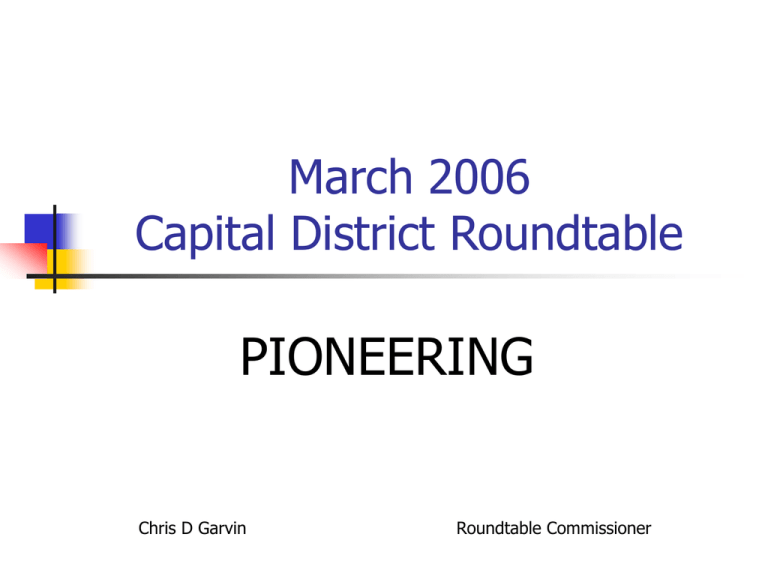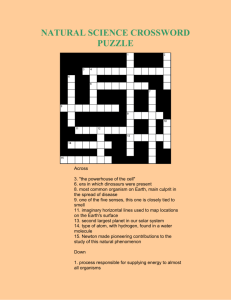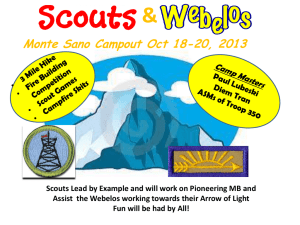Pioneering Merit Badge - Capital District News
advertisement

March 2006 Capital District Roundtable PIONEERING Chris D Garvin Roundtable Commissioner OUTLINE Introduction Pioneering Merit Badge Knots & Lashings GSS & Safety Process Project Sources Questions Site of the Month: http://hcetit.hcet.fiu.edu/pioneering.asp Pioneering Merit Badge Pioneering MB Source www.meritbadge.com/home.htm Learning Worksheet Test Your Knowledge Hobbies Merit Badge Group Pioneering MB 1. 2. (FIRST AID) Show that you know first aid for injuries or illness that could occur while working on pioneering projects, including minor cuts and abrasions, bruises, rope burns, blisters, splinters, sprains, heat and cold reactions, dehydration, and insect bites or stings. (KNOTS) Do the following: 3. 4. 5. Successfully complete Tenderfoot requirements 4a and 4b and First Class requirements 7a, 7b, and 7c. (These are the rope-related requirements.) Tie the following: square knot, bowline, sheepshank, sheet bend, and roundturn with two half hitches. Demonstrate the following: tripod and round lashings. (ROPEWORK) Explain why it is useful to be able to throw a rope, then demonstrate how to coil and throw a 40-foot length of 1/4- or 3/8-inch rope. Explain how to improve your throwing distance by adding weight to the end of your rope. (ROPE TYPES) Explain the differences between synthetic ropes and natural-fiber ropes. Discuss which types of rope are suitable for pioneering work and why. Include the following in your discussion: breaking strength, safe working loads, and the care and storage of rope. (SPLICES) Explain the uses for the back splice, eye splice, and short splice. Using 1/4- or 3/8-inch three-stranded rope, demonstrate how to form each splice. Pioneering MB 6. 7. 8. 9. 10. (MAKE ROPE) Using a rope-making device or machine, make a rope at least 6 feet long consisting of three strands, each having three yarns. (MODEL) Build a scale model of a signal tower or a monkey bridge. Correctly anchor the model using either the 1-1-1 anchoring system or the log and stake anchoring method. Describe the design of your project and explain how the anchoring system works. (TACKLE) Demonstrate the use of rope tackle to lift a weight of 25 pounds and pulling a log at least 6 inches in diameter and 6 feet long with the tackle. Use the tackle to put tension on a line. Explain the advantages and limitations of using a rope tackle. In your explanation, describe the potential damage that friction can do to a rope. (TRESTLE) By yourself, build an A-trestle OR X-trestle OR H-trestle using square and diagonal lashings. Explain the application of the trestle you build. Demonstrate how to tie two spars together using a shear lashing. (PROJECT) With a group of Scouts, OR on your own, select a pioneering project. With your counselor's guidance, create a rough sketch of the project. Make a list of the ropes and spars needed, then build the project. (Note: This requirement may be done at summer camp, at district or council events, or on a troop camp outing.) Knots and Lashings 6 Basic Knots Lashings Square, Diagonal, Tripod, Round, Sheer Japanese Square, Filipino Diagonal Whipping Square, Sheet Bend, Bowline, Clove Hitch, Two Half Hitches, Tautline, Sheepshank American, Sailmaker’s, West Country Splicing Back, Eye, Short, Long Pioneering: Square Lashing Pioneering: Diagonal Lashing Pioneering: Diagonal Lashing Pioneering: Diagonal Lashing Pioneering: Tripod Lashing Pioneering: Tripod Lashing Pioneering: Round Lashing Pioneering: Shear Lashing Japanese Square Lashing Step 1 Step 2 Step 3 Step 4 Filipino Diagonal Lashing Step 1 Step 2 Step 3 Step 4 GSS and Safety GSS does not cover Pioneering projects apart from Monkey Bridges HW Spring Camporee Rules and Guidelines Liability and Insurance Due diligence in construction Material Handling Inspections (rope and timber) Heights: (suggestions) Scouts and WEBELOS nte 12’, 6’ for Cub Scouts No plane or surface upon which a participant traverses may exceed 5’ above grade. Process 1. 2. 3. 4. 5. 6. 7. 8. 9. 10. 11. Conduct a Risk Assessment Select your Site Gather Resources Delegate Responsibilities to Knowledgeable People (Teamwork) Co-ordinate the Project (size and material) Select a Suitable Anchor Knots and Lashings Correct Prepare for the “BIG LIFT” (bracing and ropes) Up She Goes (clear area and secure the structure) Take The Strain (tighten all lines) Playtime (monitor safety and recheck often) Project Sources Scoutweb South Africa Hurricane District Pioneering Projects htttp://www.angelfire.com/sc2/SeaScouts/pioneering.html Rosegarden’s Pioneering http://www.pioneeringprojects.org/index.htm Canadian Pioneering http://www.troop125bsa.com/pioneering1.htm PioneeringProjects.org http://chuh.net/troop22/Klondike/rope.htm Troop 125 Pioneering Scout Skills http://hcetit.hcet.fiu.edu/pioneering.asp Competitions http://www.scouting.org.za/resources/pioneering/ http://www.webofroses.com/scouting/pioneering_projects.phtml UK Scouting Resources http://www.scoutingresources.org.uk/pioneering_index.html March 2006 Capital District Roundtable QUESTIONS? Capital District Roundtable Chris D Garvin cdgarvin@yahoo.com (Home) 884-5438 (Cell) 890-3222 Roundtable Archive and Info http://www.capitalscouting.org/capital_rndtbl/




